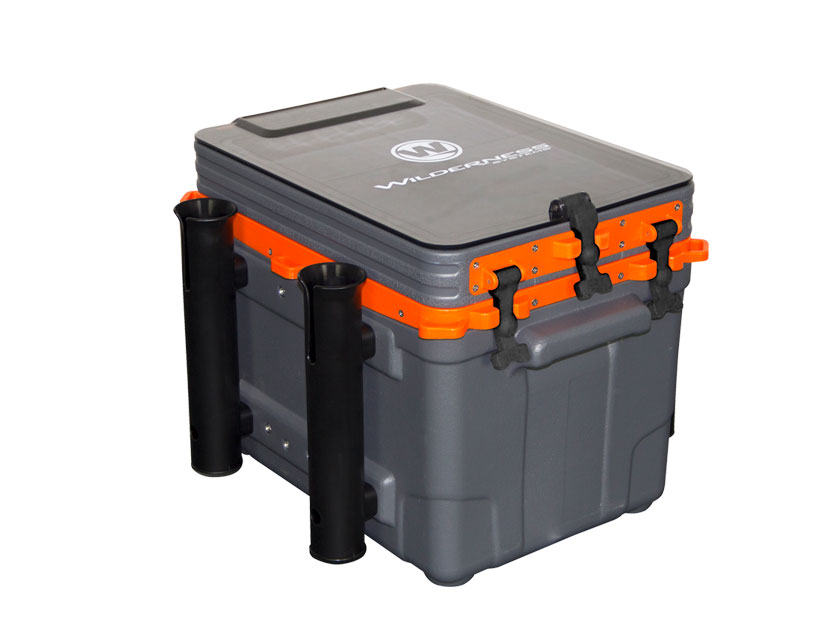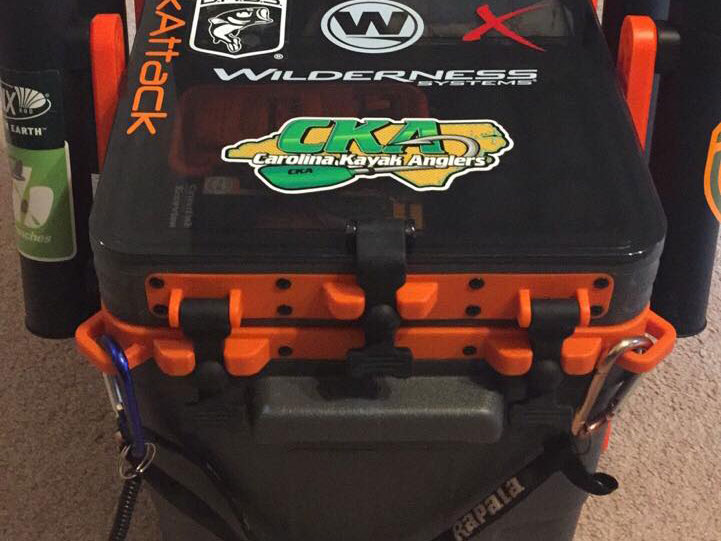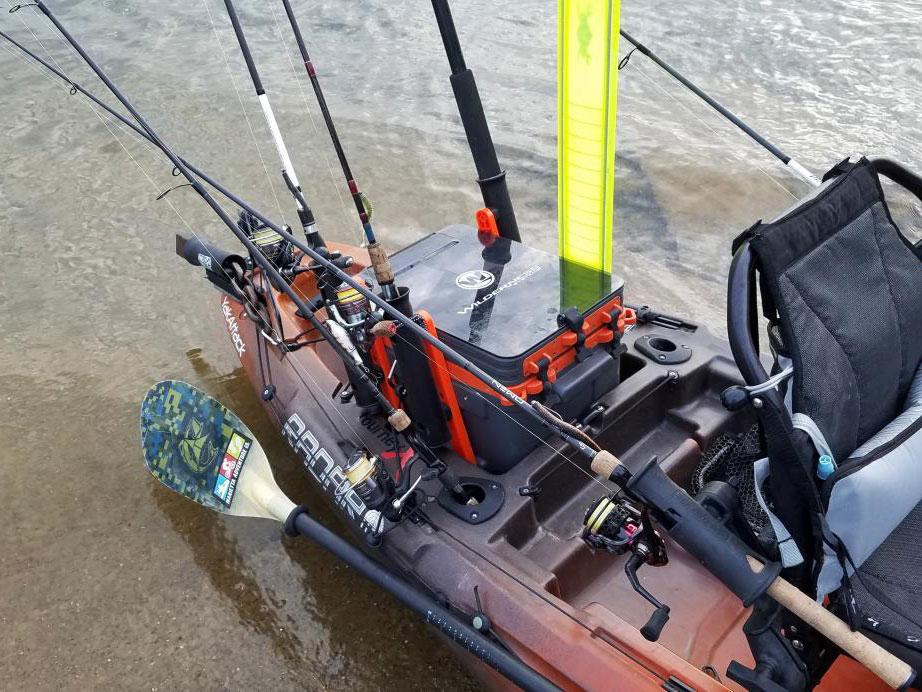Tips and Reviews
Form and Void: A Review of the Wilderness Systems Kayak Krate
In the beginning, kayak anglers created tackle storage systems from plastic milk crates. Repurposed rod holders, sometimes cut from sand spikes, were zip-tied to their plastic and stolen forms. To these crates we trusted our tackle and rods and reels as we paddled over the face of the waters. Look around you now and every year a host of new accessories begs for our attention. Most receive it. Why? Because inventive anglers, engineers and product designers have applied their creative energy to reimagining some important kayak fishing accessories. Wilderness Systems has innovated from the start with its kayaks and now the company has expanded its product line into new kayak accessories; with the Kayak Krate the company has taken the familiar square void of the tackle crate and cleverly turned it into something new.
For this article, I assembled and prepped the Krate one day and then took it on the water for several outings. I also left it sealed in the rain one night to check if the rain would find a way into it (it did not, mostly), and tested it on the water in a variety of weather, including heat, bright sun, cold and high wind. For the sake of convenience, I divided this review into 4 sections: assembly, storage space, field test notes and a final summary. Each step is evaluate don a 1-10 scale.

Assembly
The Kayak Krate is pre-molded. As such, the main casing requires no assembly. The two lids are pre-hinged, too. Here it earns convenience points with respect to the Black Pak, its primary competitor. When you remove the Krate from its box and bag, you will find 5 bags inside the Krate. One bag contains 16 pieces of stainless steel hardware, two bags contain the 4 rod holders and two bags contain orange rails. You will also find two mesh tackle bags, pre-fitted with steel rods, that slide like hanging file folders into any of 4 slots in the main compartment. So far, it’s an impressive and easy start.
At this point, you have the first of two questions to answer: do I need to mount the rails? If your kayak has a wide tankwell, the rails and 8 pieces of the hardware immediately become irrelevant. To determine if you need the rails, place the Krate in your tankwell then see if the holders will fit without the rails on each side. If they won’t fit, you will need to mount the rails for the rod holders. The rails elevate the holders so the Krate will fit in the tankwell (I fitted the Krate to an old Tarpon 130x, and I needed the rails because the tankwell was too narrow – that was not the case in a Radar 135).
You will need a common 5 mm hexagonal allen wrench to attach the rails. Now you have a second question: do you want your rods mounted vertically, or at an angle? I chose to angle mine so as to help minimize catching a rod with a back cast. Remember however that angled holders make it easier for rods to catch on a tree and slide out, so rod leashes will be a good idea. The engineers anticipated this, and pre-mounted 6 plastic loops on the sides of the Krate. Why 6? Because the loops can have many uses, but also because you can mount 2 additional rod holders (for a total of 6) if your heart desires (and if you have the cash to order the additional parts, which are relatively inexpensive).
All the screw holes are pre-drilled in the rails as well as the main compartment, and the holes in mine lined up perfectly. A Phillips head screwdriver will attach the rod holders to the rails. Here I noticed that the screws lined up perfectly but you want to be sure that the rod holder does not slip out of alignment while you screw it in, because even a small misalignment affected the screw’s ability to mount flush. I turned the Krate on its side and the problem was solved.
Despite the absence of assembly instructions, the entire process took roughly 20 minutes. Yes, I did have to check my kayak to be sure the Krate fit into my kayak’s tankwell, and some printed assembly instructions indicating how to use the rails would help some folks. Some folks might attach the rails only to find they didn’t need them (or not attach them and find they do need them). Nonetheless, the assembly was quick, and during the process I noticed the hardware was well made and that the Krate itself is aesthetically pleasing in a manner that photographs did not seem to capture. In terms of its visual design, I would compare it to the Yak Attack Black Pak in this way: the Black Pak’s sharp angles and monochrome design are a PC, and the Krate’s rounded edges and bright colors are a Mac.
Score: 9/10
Storage Space
Every angler spends time arranging tackle in storage containers. Once you make a world, you have to fill it. The Kayak Krate offers many opportunities in this regard.
The Krate has two lids. A semi-transparent one is the top lid, and it closes with a single rubber ball latch. Lift this lid and you will find a square divided into 3 shallow compartments. The two small ones are 5.50” x 4.75” and the large one, which is near the front of the lid, is 10.50” x 6.50”. They are roughly 1.25” deep, but there is additional room when the lid is shut. I was able to fit a small first aid kit, a rain poncho, a stick of sun screen, and a 3-4 small lure packages in these trays. I later noticed that the stick of sun screen began to melt in the sun, so it is perhaps wise to avoid placing items vulnerable to heat in this upper compartment. This lid also is not entirely waterproof.
The main compartment opens by releasing two rubber bungee balls. The lid stands vertically when open, at a slight angle away from the seated angler, so keep that in mind on a windy day because an open lid will create drag on your paddle stroke (or wear down a motor battery over time).
I first placed the mesh tackle bags into the two slots nearest to my seat. I didn’t like that they obscured the view of the rest of the compartment so I moved them to the back and loaded in some tackle trays. By vertically standing 4 3600 size trays on their long sides in the front, and placing two more trays of the same size on top of them, 6 trays fit in the front end. I also placed 2 more 3600 size trays beneath the tackle bags then filled the bags with 7-8 bags of soft plastic lures. I was able to also place a small waterproof container between the bags, for a total of 8.5 trays, with a little bit of room to spare. Depending on how you arrange them, you can fit between 8-12 3600 size Plano trays in the main compartment, minus the mesh bags. I then lifted the Krate by the molded handles on its ends. This was important, because a loaded Krate with rails and rods attached should carry easily. I walked about 20 yards with it to imitate a walk from a launch to a parked vehicle; it remained balanced and the handles were not too shallow, for a firm grip.

Having arranged tackle, I set about to attach rod leashes. As noted above, the Krate has 6 plastic loops (3 down each side, just below the lid line). Standard carabiner clips fit into these, too, so I attached a leash and placed a 3rd carabiner clip over the middle of the leash. I used this 3rd clip to snap through the metal loop behind my kayak seat, creating an anchor point in case of a spill. I’m glad I did, as we shall later see. I then passed a bungee from the middle loop around the back and to the other middle loop. Here I secured a measuring board, and tethered it with a leash to the bungee. I imagine this could be used to hold a net, too.
In sum, despite being pre- fabricated, the Krate can be modified with attachments for many uses. It is not merely an empty box; rather, it is a functional space. The Wilderness Systems engineers did well to create a storage form that could be customized without necessarily requiring that anglers do so. Once it is assembled, it can go immediately to work, but it can also be modified to one’s tastes or needs. Most importantly, it can be secured in a variety of ways.
Score: 10/10
Now, to put the Krate through the ringer…..
Field Tests
When I loaded the Krate into the seat of my vehicle, it tilted and fell over on the first curve. The fact that it is top heavy when the extender rails and rod holders are attached is something to keep in mind (and all the more reason to secure it well to your kayak). Here the Yak Attack Black Pak, with its slightly less rectangular design and low center of gravity, has an advantage, depending on your preference. But if you fish moving or windy water, or are spill prone, keep this in mind.
I launched on the first day into a stiff, cold wind, so wind resistance was on my mind. I found there was no appreciable effect when the lid was closed. I made sure to bring 5 rods so that there would always be a rod in each of the 4 holders, and I spent nine hours on the water. Depending on the style of fishing, I made between 25-40 casts per hour, and made somewhere in the ballpark of 300 casts that day without once hooking a rod on the backcast. I was able to turn and reach tackle with relative ease, even from the mesh bags in the back of the main compartment, and while the wind gusts reached 10-12 mph the lid did not slam shut on my hand. I did notice one flaw. When reaching back one time, a reel was facing inwards, over the Krate lid. When I lifted it, the reel lifted, too, but not enough to lift the rod entirely out of the holder before I saw what was happening. Again, use a leash, just in case this happens and the lid-opening motion sends a rod, or rods, into the deep.
I left the lid open for a bit while paddling, too, and because there was some spray I found some water in the Krate when I was finished. The Krate does not have weep holes, a fact I noted during assembly. I am not sure what the reasoning behind this may have been, but it could be that it is because the Krate has a double-walled form and weep holes would require some sort of inserts to prevent mold from building up between the walls. This is not a design flaw but a design choice, and I would recommend the Krate lids be shut if it rains so as to avoid compromising gear and adding weight to your paddling effort.
I returned to the water on the second day with a more specific test in mind. I placed the Krate into the tankwell over a steep bank. I wanted to see if wave activity, or a lean to the kayak’s tipping point, would send the Krate overboard. So I violently rocked the kayak so as to create an artificial wave pool. Here, I noticed something interesting: while the rails and rod holders add weight to the top of the Krate, they also make the holders extend over the kayak’s top-side surface. When the Krate tilted, the rod holders touched the kayak’s sides and prevented the Krate from tilting so far that it might spill out. This was a pleasant surprise. You should nonetheless secure the Krate to your kayak in some way, regardless of whether you attach the rails or not, as any storage system can spill if you flip your kayak.
Score: 9/10

Final Evaluation
Overall, the Kayak Krate assembled easily, stored tackle in creative ways and handled well on the water. An angler who takes a few additional steps to secure the container to the kayak and fishing rods to the Krate is then free to focus on enjoying the Krate’s innovative space-organizing features. The only true flaw I noticed was that the act of opening the lid when the rod holders are raised by the rails could catch a spinning reel that is turned inward and flip the reel and rod out of the holder (this flaw is eliminated if you do not attach the rails, because the rod holders are lower). Some might say that is an angler usage issue, but even the handle on a slightly turned spinning reel could be caught. Again, that tragedy can be prevented with a rod leash or rod float.
Finally, the Krate is the best-looking tackle storage system on the market, a fact that was not communicated well by the product photos I saw. If aesthetic points carry any weight for you, this product earns a perfect store in that category. In my view, the best products combine aesthetic features with functionality – why make a world from the void, and not have it please the eye? The Kayak Krate effectively reconceives how we imagine a tackle storage system in a compact, multi-purpose design.
For more about the Wilderness Systems Kayak Krate, click here: https://www.wildernesssystems.com/us/products/kayak-krate
[Note: An early version of this article appeared on the Get Outdoors Pedal and Paddle website in 2019. It has been slightly modified and updated for BassTrail.com].
Hank Veggian is a multi-species freshwater kayak angler. He is a member of the Jackson Kayak Fishing Team, Ketch Products Fishing Team and Get Outdoors Pedal and Paddle Pro Staff. His writings on fishing have been published in numerous magazines. Follow him on Twitter @miacalva and visit his website at www.bowfincountry.com
Hank Veggian is a multi-species freshwater kayak angler. He is a member of the Jackson Kayak Fishing Team, Ketch Products Fishing Team and Get Outdoors Pedal and Paddle Pro Staff. His writings on fishing have been published in numerous magazines. He has written for the KBF and KAS websites, and is a former KFL angler.

Comments
Be the first to comment on this article!